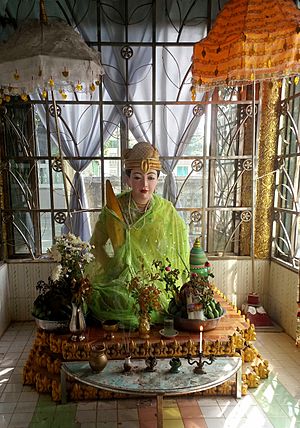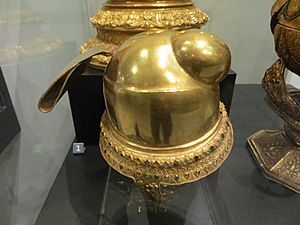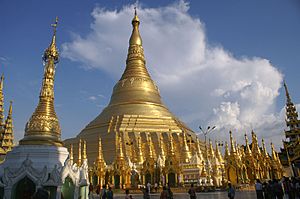Shin Sawbu facts for kids
Quick facts for kids Shin Sawbuရှင်စောပု |
|
|---|---|

Statue of Queen Shin Sawbu
|
|
| Queen regnant of Hanthawaddy | |
| Reign | 1454–1471 |
| Predecessor | Leik Munhtaw |
| Successor | Dhammazedi |
| Queen of the Central Palace of Ava | |
| Reign | August 1426 – 1429 |
| Predecessor | herself |
| Successor | Dhamma Dewi of Ava |
| Queen of the Central Palace of Ava | |
| Reign | December 1423 – August 1425 |
| Predecessor | Min Pyan of Ava |
| Successor | herself |
| Born | 11 February 1394 Wednesday, 12th waxing of Tabaung 755 ME Pegu (Bago) Hanthawaddy Kingdom |
| Died | 1471 (aged 77) Dagon Hanthawaddy Kingdom |
| Burial | Sanchaung |
| Consort | Binnya Bwe (c. 1413–1419) Thihathu (1423–1425) Tarabya Minye Kyawhtin (1425–1426) Mohnyin Thado (1426–1429) |
| Issue | Binnya Waru Mi Pakahtaw |
| House | Hanthawaddy |
| Father | Razadarit |
| Mother | Thuddhamaya |
| Religion | Theravada Buddhism |
Shin Sawbu (Burmese: ရှင်စောပု; 1394–1471) was a powerful queen who ruled the Hanthawaddy Kingdom from 1454 to 1471. She is also known as Binnya Thau, which means "Old Queen" in the Mon language. Shin Sawbu is one of the few queens who ruled in mainland Southeast Asia. She is as famous as Queen Jamadevi of Haripunjaya.
Contents
Early Life and Family
Shin Sawbu was born on February 11, 1394, in Pegu (now Bago). Her father was King Razadarit of the Mon people. Her mother was Queen Thuddhamaya. Shin Sawbu was their only daughter.
When she was 20, she married Binnya Bwe. They had a son named Binnya Waru and two daughters. Sadly, her husband died when she was only 25 years old.
Life in Ava
In 1421, Shin Sawbu's father, King Razadarit, passed away. Her older brother, Binnya Dhammaraza, became king. But his younger brothers rebelled against him.
In 1423, King Thihathu of Ava came with his army to help one of the rebellious brothers. To make peace, Shin Sawbu's brother, the Crown Prince Binnya Ran, offered her to King Thihathu. Shin Sawbu moved to Ava in December 1423.
She was 29 years old when she arrived in Ava. She was a widow with three children. King Thihathu liked her very much. However, he died in 1425 during a military trip. Shin Sawbu stayed in Ava for four more years.
During her time in Ava, she supported two Mon monks, Dhammanyana and Pitakahara. They lived in a monastery near Ava. In 1429, when she was 35, Queen Shin Sawbu escaped from Ava. Her monk teachers helped her. She returned to Pegu with them.
Becoming Queen of Pegu
By 1454, there were no more male heirs left in Pegu to become king. So, Shin Sawbu became queen in early 1454. Two of her brothers and one of her sons had already ruled as kings before her.
In 1457, the Buddhist world celebrated a special event. It was the 2,000th anniversary of the Buddha's passing.
After ruling Pegu for about seven years, Queen Shin Sawbu made a big decision. In 1460, she decided to step down from the throne. She wanted to move to Dagon to live a religious life. She wanted to be close to the famous Shwedagon Pagoda.
Shin Sawbu chose a monk to be the next ruler of Pegu. This was Pitakahara, one of the monks who helped her escape from Ava. He left his monk life and was given new titles. He also married her younger daughter, Mipakathin. This made him a good choice to become king.
Life and Work in Dagon
Shin Sawbu lived in Dagon next to the Shwedagon Pagoda until she died in 1471. Even after she moved, people say she still wore a crown.
The queen officially gave power to Dhammazedi in 1457. He became king with the title Ramadhipati. This event is recorded in an old stone writing in the Mon language.
In Dagon, the queen spent her time improving the Shwedagon Pagoda. She made the platform around the pagoda larger. She paved it with stones. She also put stone posts and lamps around the outside. She even expanded the lands that supported the pagoda.
Shin Sawbu often did things in groups of four. For example:
- There were four white umbrellas.
- There were four golden alms-bowls.
- Four offerings were made every day.
- She built and strengthened a seven-layered wall around the pagoda.
- Between the walls, she had palm and coconut trees planted.
She also donated her own weight in gold to the pagoda. This gold was made into thin sheets called gold leaf. She used it to cover the Shwedagon Pagoda. The people of Dagon also gave a lot of bronze to the pagoda.
Old Stories and Traditions
Many stories are told about Queen Shin Sawbu. Some people in the late 1800s even thought the British Queen Victoria was Shin Sawbu reborn!
One famous story tells how she chose her successor. After ruling for seven years, she wanted to give up her throne. She came up with a clever way to pick between the two monks who had helped her escape from Ava.
One morning, when the monks came for their food, she secretly put a layman's dress and tiny models of royal items into one of their bowls. She prayed that the right person would get it. The bowl with the items went to Dhammazedi. He then left his monk life, married her daughter, and became the new ruler.
Another story explains how she got the name "Old Queen" (Baña Thau). One day, while being carried through the city, an old man complained about being pushed aside. He said, "I'm not so old that I couldn't have a child, which is more than your old queen could do!" Shin Sawbu was surprised but accepted this as a sign. From then on, she called herself "The Old Queen."
Where She Lived and Was Buried
Some people believe that the ruins of Shin Sawbu's home in Dagon are now part of a golf course. However, others say these ruins are actually a wall built much later.
Her burial place is said to be at a monastery in Sanchaung Township in modern-day Yangon. It is near the Shwedagon Pagoda. The monastery was once called the Shin Sawbu Tomb Monastery.
Images for kids






